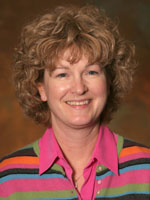
Jean Schwarzbauer
Princeton University
Making Connections
In 2007 we will celebrate the twenty-fifth anniversary of the Fibronectin, Integrins, and Related Molecules GRC. In 1982 I attended the very first meeting, then named simply Fibronectin, which had been spun off from the Collagen GRC. As a young postdoc I switched from bacterial protein chemistry to mammalian extracellular matrix biology and was still learning about my newly chosen field of research.
The large and impersonal meetings like Keystone and Federation of American Societies for Experimental Biology that I had previously attended were nothing like my first Gordon Conference. The GRC atmosphere was completely different. I loved being able to sit at the dinner table with the leaders in extracellular matrix biology and eavesdrop on their discussions. It is no surprise that I have very fond memories of that conference. I have been a devoted attendee at subsequent Fibronectin Gordon Conferences, and I served as its chair in 1995.
The first Fibronectin GRC covered a wide range of topics–everything from clinical studies to hard-core biochemistry. Subsequent meetings have been focused on timely central issues, and some meeting themes have had a cyclical life. A memorable controversy at the 1982 meeting, for example, was whether fibronectin, which is a very large protein, had an extended or compact structure. Groups from the United States, Switzerland, and the Soviet Union showed data obtained using a newly developed single-molecule electron microscopic (EM) technique. But each group had used a different solution for depositing fibronectin on the EM grids, and the differences resulted in dramatically different pictures of fibronectin. At the time we thought only one of these structures could be correct. As it turns out, each of these original configurations can occur under particular physiological conditions. Today we still do not know quite what fibronectin looks like, and the topic of its structure remains an important and interesting part of the Fibronectin GRC.
The conference’s central focus has changed from fibronectin to other molecules and processes over the years. The most significant topic change occurred in 1987 at the conference’s third meeting, when many of the presenters’ talks involved integrins–newly discovered cell receptors for fibronectin and related molecules. Few of us could foresee the impact that integrins would have on biology and medicine. At the time we were more interested in confirming commonality of the bands on protein gels from different labs or determining whether the proteins found in flies were the same as those in chicken or human samples. It became clear, however, that these receptors were setting a new direction for the field. The 1987 meeting changed the face of extracellular matrix biology.
Recurring meetings are advantageous in that they reflect current interests and can predict future issues in a field. The Fibronectin GRC has done just that by being at the forefront of the field. The excitement over integrins in 1987 was followed by other major turning points for the field, including understandings of the link between fibronectin and signal transduction cascades, of crystal structures for parts of fibronectin and integrins, and of knock-out and knock-in phenotypes in mice.
The personal connections and new ideas that I have developed at this GRC have greatly affected my scientific career. At this conference I gave my first major talk as an assistant professor and made my first European connection, which resulted in an invitation to speak in France. Also important, as a resident in the “girls’ dorms” of the New England sites, I have made lasting friendships with other women scientists. Finally, the impact of the Fibronectin GRC is illustrated by the large number of scientists who have attended since its first meeting. Many of the faces that appeared in the 1982 conference photograph can also be found in the 2005 photo, albeit with a few more wrinkles.